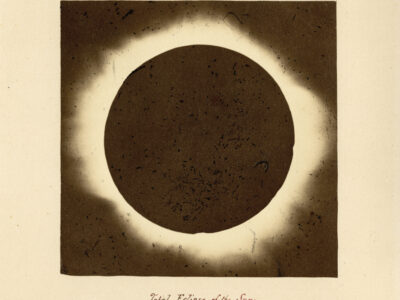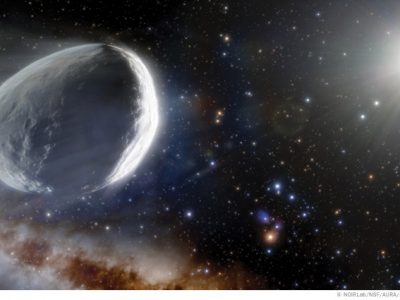This past winter, Dr. Douglas Cowen, assistant professor of physics and astronomy, traveled to Antarctica — then in mid-summer — to search for an elusive kind of particle, using what he describes as the “world’s first functioning large-scale neutrino telescope.” When he returned to campus, he filed the following report for the Gazette.
THE sun circles overhead at a constant angle, never setting. The summertime temperature hovers around -20 F, except when there is a breeze, which can cause it to dip to a wind-chilled -60 F. And if Mother Nature is sending any ultrahigh-energy neutrinos our way, we are going to see them, thanks to the clarity and depth of the local ice — and to AMANDA, the world’s first functioning large-scale neutrino telescope.
Welcome to the South Pole, where the National Science Foundation’s Amundsen-Scott South Pole station supports a wide variety of scientific experiments — including the “Antarctic Muon and Neutrino Detector Array,” better known as AMANDA, which Penn is working on. (Penn’s astrophysicists, among the world’s leaders in the field, have been probing this subject since the inception of neutrino astronomy some 30 years ago, and its theoreticians are recognized international experts in neutrino physics.) Unlike the typical telescope, which detects the particles of light known as photons, AMANDA aims to be the first to look at the neutrino sky. And it might enable us to see even more, though we can’t predict what — after all, when Galileo turned the first spyglass on the heavens, he discovered craters on the moon and the moons of Jupiter, and when Nobel Laureates Arno Penzias and Robert Wilson first pointed a very sensitive antenna at the sky, they discovered direct evidence for the Big Bang. For physicists, unexpected discoveries are part of the lure of exploration.
Our immediate challenge, though, is getting to the bottom of the world. After flying to Christchurch, New Zealand — where the summer heat mocks our Extreme Cold Weather gear — we board a series of battered Hercules C-130 military cargo planes. A dark comedy of mechanical problems and bad weather sends us twice boomeranging back to New Zealand, but finally we touch down on the ice in Antarctica, just 30 minutes’ drive to McMurdo station on the Antarctic coast. The weather is blindingly clear, and the nearby mountain peaks — some 14,000 feet high — bring to mind the Swiss Alps. Two days later, after more foul-weather delays, we fly the last three-hour leg of the journey from McMurdo to the South Pole. It’s marked by a four-foot nail in the ice, as well as a nearby volleyball net, a Christmas tree and a pole — this one of the barbershop variety, which someone put there as a joke. Actually, there is a long line of South Pole markers, since each year a new one is added as the polar ice-cap moves about an inch a day over the earth below. An expanse of painfully bright snow extends out to the horizon in all directions. If it snowed on the moon, it would look like this.
The long line of South Pole markers point toward the sunken South Pole Dome, which shelters a number of smaller buildings inside — keeping them from drowning in the snow drifts which, over the years, have buried the Dome in 15 feet of snow. We settle into our dormitory rooms — actually heavy-duty tents — and gradually get acclimated to the 11,000-foot altitude before we get to work looking for ultrahigh-energy neutrinos.
An astronomer can only use a particle to map the sky if it has traveled in a straight line. Photons do this, but they gradually diminish in number at higher energies — presumably because they are produced very far away and are prone to getting absorbed by things like intervening interstellar dust. Other particles — protons, for example — can also be useful to astronomers, but only when their energies are extremely high, since otherwise their trajectories get hopelessly distorted by our galaxy’s magnetic field.
Between the relatively low energies of detected photons
and the very high energies of protons with straight trajectories lies
a gargantuan blind spot in our view of the universe — one which only
neutrinos can illuminate, since they rarely get absorbed like photons
and aren’t affected by magnetic fields like protons.
Neutrinos, including those produced in the fusion-interactions
in the core of the sun, are notoriously antisocial particles. Each second,
about one quadrillion neutrinos — that’s 1,000,000,000,000,000 — pass
through your body, though during your lifetime only a handful will actually
deign to recognize your existence by banging into your body’s atoms. The
neutrino can do this because it is the smallest of all known particles
— so small that to them, the tiny spaces between the atoms in your body
look like gaping holes. And they continue on their way, passing through
the entire earth unscathed, traveling in straight lines into the cosmos.
Theorists estimate that about 300 neutrinos occupy every single cubic
centimeter of the universe, making them one of the most ubiquitous things
around.
And those are just the low-energy neutrinos. There are
also higher-energy neutrinos, and as their energy increases, so does their
sociability. Fortunately for our bodies and other living things, they
also become considerably less numerous. The ultrahigh-energy neutrinos
— the quarry of AMANDA — are thought to be produced in some of the most
violent structures in the universe, known as “active galactic nuclei,”
or AGN. AGN are believed to be supermassive black holes (about one billion
times more massive than the sun) at the center of rather unfortunate galaxies.
As an AGN insatiably draws matter into its gullet, particles are accelerated,
smashing into one another. Neutrinos produced in these cosmic collisions
escape from the maelstrom — and some may bang into our ice-bound detector,
AMANDA.
A 20-minute stroll from the South Pole station past
the geographic South Pole (or a short but surreal mountain-bike ride)
takes you to the laboratory which houses AMANDA and several other experiments.
AMANDA consists of a set of 13 long lines of exquisitely sensitive light
detectors, arranged like beads on a string and each dropped into 1.5-mile-deep,
25-inch-wide holes melted into the ice with a custom-designed hot water
drill. Once the holes refreeze we turn on our detectors by applying high
voltage to them and look for electric pulses left behind by neutrino interactions.
The neutrino itself does not produce light directly,
but if it collides with an atom of ice, it produces charged particles,
and often these particles have sufficient energy to travel faster than
light in ice. (Nothing goes faster than light in vacuum, but light travels
more slowly in ice, so in that medium particles can outrun light.) These
fast, charged particles emit a shock wave of light, not unlike the way
a supersonic plane emits a shock wave of sound, or sonic boom. It is this
light that our sensors can detect.
Ironically, photons are the signature we are looking
for, but unlike astronomers’ photons, neutrinos make our photons deep
inside the Antarctic ice cap. So deep, in fact, that they could only have
come from penetrating particles such as neutrinos. The clarity of the
ice is also a big plus, for it means that any photons which are produced
by neutrinos can travel a long way, and that means that we do not need
huge numbers of photon-detectors to do the job. Theorists think that the
size of our current detector array may enable us to see a handful of ultrahigh-energy
neutrinos over the course of a year. So we are looking carefully and closely
at our data for that precious needle in the haystack, and we even go so
far as to keep the apparatus running during the austral winter, when the
South Pole is inaccessible and only a handful of hardy “winter-overs”
populate the station. We also continue to make the detector larger, sinking
several new strings of detectors each year. (The first AMANDA detector
string was sunk into the ice in the 1993-94 season.) Eventually, with
a little luck, we may catch the first ultrahigh-energy neutrino ever seen
— and toast a new and exciting era in astronomy.




